Permaculture companion plants for Celery
| Image | Name | Data | Description | Actions |
|---|---|---|---|---|

|
Runner Bean |
1-12
Annual, Perennial
Full sun
Moist
Light (sandy), Medium, Heavy (clay)
3.0
true
Flowers, Leaves, Root, Seed, Seedpod
https://en.wikipedia.org/wiki/Phaseolus_coccineus
Fast
Scarlet runner, scarlet runner bean, scarlet conqueror, fire bean, mammoth, red giant phaseolus coccineus ssppolyanthus (cache bean)
Fabaceae or leguminosae
https://pfaf.org/User/Plant.aspx?LatinName=Phaseolus coccineus
Guatemala, Honduras, Mexico Central, Mexico Gulf, Mexico Northeast, Mexico Northwest, Mexico Southeast, Mexico Southwest, Nicaragua, Panamá
Alabama, Amur, Assam, Baltic States, Bangladesh, Belarus, Bulgaria, Central European Rus, China North-Central, China South-Central, China Southeast, Colombia, Czechoslovakia, East European Russia, East Himalaya, Ecuador, Ethiopia, India, Inner Mongolia, Jawa, Kenya, Khabarovsk, Kirgizstan, Korea, Manchuria, Nepal, New Guinea, New Zealand North, New Zealand South, North European Russi, Northwest European R, Pakistan, Primorye, Rwanda, South European Russi, Tanzania, Transcaucasus, Ukraine, Uzbekistan, Wake I., West Himalaya
3-5 years
https://powo.science.kew.org/taxon/urn:lsid:ipni.org:names:513754-1
Nitrogen fixer
|
Show
Edit |
|
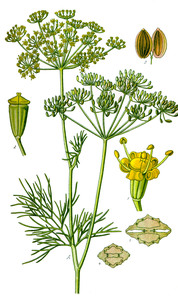
|
Anethum graveolens |
2-11
Full sun
Moist
Light (sandy), Medium
0.8
Annual
Herbs
Medium
15cm x 30cm
Essential Oil, Pest control, Fragrance
true
Leaves, Seed
Condiment, Tea
Dill
Apiaceae or umbelliferae
Algeria, Chad, Cyprus, Gulf States, Iran, Lebanon-Syria, Libya, Morocco, Oman, Saudi Arabia, Tunisia
Afghanistan, Alabama, Albania, Alberta, Altay, Andaman Is., Angola, Argentina Northeast, Arizona, Arkansas, Assam, Austria, Azores, Bahamas, Baleares, Baltic States, Bangladesh, Belarus, Belgium, Brazil South, Brazil Southeast, British Columbia, Bulgaria, California, Cameroon, Canary Is., Cape Verde, Cayman Is., Central European Rus, China North-Central, China South-Central, China Southeast, Connecticut, Costa Rica, Cuba, Czechoslovakia, Delaware, Denmark, Dominican Republic, East Aegean Is., East European Russia, East Himalaya, Ecuador, Eritrea, Ethiopia, Finland, France, Ghana, Great Britain, Greece, Guatemala, Haiti, Hawaii, Hungary, Illinois, India, Indiana, Iowa, Iraq, Italy, Jamaica, Kansas, Kazakhstan, Kentucky, Kenya, Kriti, Krym, Laos, Leeward Is., Louisiana, Madeira, Maine, Manitoba, Maryland, Massachusetts, Michigan, Minnesota, Missouri, Mongolia, Montana, Mozambique, Nebraska, Nepal, Netherlands, New Jersey, New York, Nicobar Is., Niger, Nigeria, North Carolina, North Dakota, Northwest European R, Norway, Ohio, Oklahoma, Ontario, Oregon, Pakistan, Palestine, Pennsylvania, Peru, Portugal, Primorye, Puerto Rico, Québec, Rhode I., Romania, Saskatchewan, Sicilia, Somalia, South Dakota, South European Russi, Spain, Sudan, Sweden, Switzerland, Tadzhikistan, Tanzania, Texas, Thailand, Transcaucasus, Trinidad-Tobago, Turkey, Turkey-in-Europe, Ukraine, Uzbekistan, Vietnam, Virginia, Wake I., Washington, West Virginia, Windward Is., Wisconsin, Yugoslavia
https://en.wikipedia.org/wiki/Dill
https://pfaf.org/User/Plant.aspx?LatinName=Anethum graveolens
https://powo.science.kew.org/taxon/urn:lsid:ipni.org:names:837530-1
Dill
|
Dill (Anethum graveolens) is a plant native to the eastern Mediterranean region and West Asia. It is an annual herb that grows to a height of about 1-2 feet and has delicate, feathery leaves. The plant has small yellow flowers that bloom in the summer. Dill is a popular herb in many cuisines, especially in European and Middle Eastern dishes. It is used to flavor soups, stews, fish, and pickles. The leaves and seeds of dill are both edible and can be used fresh or dried. The seeds have a more pungent flavor than the leaves and are often used in pickling. Dill can be stored by drying or freezing the leaves and seeds. Dill prefers full sun and well-drained soil. It is easy to grow and can be started from seed or from transplants. Dill is not winter hardy and will die off in the winter. In addition to its culinary uses, dill has been used medicinally to aid in digestion and to reduce inflammation. It has also been used as a natural insect repellent. The plant is attractive to many types of beneficial insects, making it a valuable addition to any garden. |
Show
Edit |
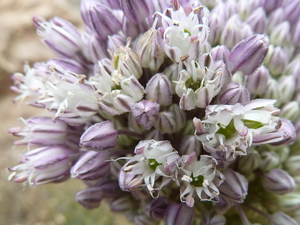
|
Allium ampeloprasum |
5-9
Full sun
Dry, Moist
Light (sandy), Medium, Heavy (clay)
1.8
0.3
Herbs
true
Flowers, Leaves, Root
Broadleaf wild leek
Lauch
Alliaceae
Albania, Algeria, Baleares, Bulgaria, Cyprus, East Aegean Is., Egypt, Ethiopia, France, Greece, Iran, Iraq, Italy, Kriti, Lebanon-Syria, Libya, Morocco, Palestine, Portugal, Romania, Sardegna, Sicilia, Sinai, Spain, Transcaucasus, Tunisia, Turkey, Turkey-in-Europe, Turkmenistan, Uzbekistan, Yugoslavia
Alabama, Argentina Northeast, Azores, Baltic States, Belarus, California, Canary Is., Central European Rus, Cuba, Czechoslovakia, Dominican Republic, East European Russia, Galápagos, Great Britain, Haiti, Illinois, Ireland, Kentucky, Madeira, Mexico Central, Mexico Northeast, Mexico Northwest, Mexico Southeast, Mexico Southwest, New South Wales, New York, North European Russi, Northwest European R, Pakistan, Puerto Rico, South Australia, South European Russi, Tasmania, Tennessee, Texas, Ukraine, Victoria, Western Australia
https://en.wikipedia.org/wiki/Allium_ampeloprasum
https://pfaf.org/User/Plant.aspx?LatinName=Allium ampeloprasum
https://powo.science.kew.org/taxon/urn:lsid:ipni.org:names:332079-2
|
Show
Edit |
|

|
Marjoram |
6-9
Perennial
Full sun, Partial sun/shade
Dry, Moist
Light (sandy), Medium, Heavy (clay)
0.6
Herbs
true
Leaves
https://en.wikipedia.org/wiki/Marjoram
Lamiaceae or labiatae
Majoran
https://pfaf.org/User/Plant.aspx?LatinName=Origanum majorana
Cyprus, Turkey
Algeria, Azores, Baleares, Baltic States, Corse, Czechoslovakia, Great Britain, Greece, India, Italy, Juan Fernández Is., Krym, Libya, Madeira, Morocco, Spain, Switzerland, Tunisia, Ukraine, Venezuela, Yugoslavia
https://powo.science.kew.org/taxon/urn:lsid:ipni.org:names:453303-1
Condiment, Tea
Disinfectant, Dye, Essential Oil, Fragrance
|
Marjoram (Origanum majorana) is a herbaceous plant that is native to the Mediterranean region. It has delicate, oval-shaped leaves that are pale green in color, and small white or pink flowers that grow in clusters. The plant grows to a height of about 30 cm and has a woody stem. In terms of growing conditions, marjoram prefers well-drained, light soil and full sun to partial shade. It can be grown from seeds or cuttings, and should be spaced about 30 cm apart. Marjoram is winter hardy in mild climates, but may need to be protected or brought indoors in colder regions. Marjoram has a number of culinary uses. It is often used as a flavoring in soups, stews, and sauces, and can be added to salads and other dishes as a garnish. The leaves and flowers of the plant are edible and can be used fresh or dried. When harvesting marjoram, it is best to pick the leaves early in the morning when they are at their most flavorful. The leaves can be stored in an airtight container in a cool, dark place for up to six months. In addition to its culinary uses, marjoram has also been used medicinally as an antiseptic and as a remedy for digestive problems. It is also sometimes used in perfumes and soaps. Marjoram is not particularly attractive to wildlife, but it can provide habitat for some beneficial insects such as bees and butterflies. |
Show
Edit |
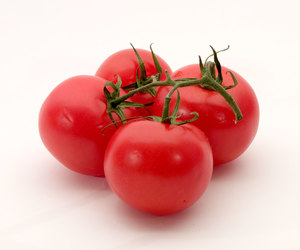
|
Tomato |
10-12
Annual, Perennial
Full sun
Moist
Light (sandy), Medium, Heavy (clay)
2.0
True
Fruit, Seed
https://en.wikipedia.org/wiki/Tomato
Fast
Garden tomato, Dumádu, Garden tomato, Love apple, Lycopersicum esculentum, Tomate, Tomato, Tomato extract containing lycopene, Tomato|thakkali, Tumatis, Lycopersicon esculentum
Solanaceae
Tomate
Oil
https://pfaf.org/User/Plant.aspx?LatinName=Solanum lycopersicum, https://pfaf.org/User/Plant.aspx?LatinName=Lycopersicon esculentum
Start seeds indoors 5-6 weeks before last frost
In containers or in rows in beds around last frost date
6.2-6.8
70-80°f
Peru
Alabama, Alaska, Andaman Is., Angola, Arizona, Arkansas, Assam, Austria, Azores, Bahamas, Bangladesh, Belarus, Benin, Bolivia, British Columbia, Bulgaria, Burkina, California, Cambodia, Cameroon, Canary Is., Cape Verde, Caroline Is., Central African Repu, Chagos Archipelago, Chatham Is., Christmas I., Colombia, Comoros, Connecticut, Cook Is., Costa Rica, Cuba, Cyprus, Czechoslovakia, Delaware, Dominican Republic, East Aegean Is., East European Russia, East Himalaya, Ecuador, Fiji, Florida, Galápagos, Georgia, Gilbert Is., Gulf of Guinea Is., Haiti, Hawaii, Illinois, India, Indiana, Iowa, Ivory Coast, Jawa, Kansas, Kazakhstan, Kentucky, Korea, Laccadive Is., Laos, Leeward Is., Line Is., Louisiana, Madagascar, Madeira, Maine, Malawi, Mali, Marianas, Marquesas, Marshall Is., Maryland, Massachusetts, Mauritania, Mauritius, Michigan, Mississippi, Missouri, Montana, Mozambique, Myanmar, Namibia, Nansei-shoto, Nauru, Nebraska, Nepal, Nevada, New Brunswick, New Caledonia, New Hampshire, New York, New Zealand North, Nicaragua, Nicobar Is., Niue, North Carolina, North Dakota, Nova Scotia, Ogasawara-shoto, Ohio, Ontario, Oregon, Pakistan, Panamá, Pennsylvania, Philippines, Pitcairn Is., Puerto Rico, Québec, Rhode I., Réunion, Saskatchewan, Selvagens, Society Is., South Carolina, South European Russi, Tadzhikistan, Taiwan, Tennessee, Texas, Trinidad-Tobago, Tuamotu, Tubuai Is., Turkey, Turkmenistan, Tuvalu, Utah, Uzbekistan, Venezuela, Vermont, Vietnam, Virginia, Wake I., Wisconsin, Zambia, Zaïre, Zimbabwe
1.00
https://powo.science.kew.org/taxon/urn:lsid:ipni.org:names:316947-2
|
The tomato is a flowering plant native to South America. It is a member of the nightshade family and closely related to the potato. The tomato plant typically grows to a height of 1-3 meters and has a weak, hairy stem. The leaves are arranged alternately on the stem and are typically dark green in color. The plant produces small yellow or white flowers, which develop into the fruit we know as tomatoes. The fruit itself is typically red, but can also be yellow, orange, green, or purple. Indeterminate tomato plants are perennials in their native habitat, but are cultivated as annuals. Determinate, or bush, plants are annuals that stop growing at a certain height and produce a crop all at once. Tomatoes prefer warm, sunny growing conditions and well-drained, humus-rich soil. They can be grown in a variety of soil types, but perform best in soil with a pH between 6 and 6.8. In order to cultivate tomatoes successfully, growers may need to provide support for the plant (such as a stake or cage) to prevent the fruit from weighing down the stem, and may also need to water and fertilize the plant regularly. Tomatoes are generally considered to be frost-sensitive, so in areas with cold winters they may need to be grown in a greenhouse or indoors. There are a great number of cultivars. The edible parts of the tomato plant are the fruit and the leaves. The fruit can be eaten raw or cooked, and is commonly used in a variety of dishes, such as salads, sandwiches, and pasta. The leaves, although not commonly eaten, are also edible and have a slightly bitter taste. After harvest, tomatoes can be stored at room temperature, in a cool place, or in the refrigerator. |
Show
Edit |
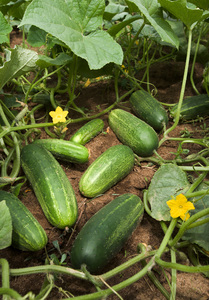
|
Cucumis sativus |
9-11
Annual
Full sun
Moist
Light (sandy), Medium, Heavy (clay)
2
Vines
Fruit, Leaves, Seed
Seed - direct sow, Seed - transplant
1 week after last frost
https://en.wikipedia.org/wiki/Cucumber
Cucurbitaceae
Gurke
50-65
23cm
6.0-6.8
15-30°C (60-85°F)
https://pfaf.org/User/Plant.aspx?LatinName=Cucumis sativus
True
Fruit
Assam, Bangladesh, China South-Central, China Southeast, East Himalaya, Myanmar, Nepal, Thailand, West Himalaya
Alabama, Albania, Andaman Is., Arizona, Arkansas, Austria, Bahamas, Bolivia, Caroline Is., Cayman Is., Colombia, Costa Rica, Cuba, Czechoslovakia, Denmark, Dominican Republic, Ecuador, Florida, Georgia, Gulf of Guinea Is., Haiti, Illinois, India, Jamaica, Kansas, Kazakhstan, Kentucky, Korea, Laos, Leeward Is., Louisiana, Marianas, Marshall Is., Massachusetts, Michigan, Mississippi, Missouri, New Caledonia, New York, Nicaragua, Nicobar Is., North Carolina, North Caucasus, Ohio, Oman, Ontario, Pakistan, Pennsylvania, Pitcairn Is., Puerto Rico, South Carolina, Sri Lanka, Sweden, Tadzhikistan, Trinidad-Tobago, Turkmenistan, Utah, Uzbekistan, Venezuela, Vietnam, Virginia, Windward Is., Zaïre
2-3 weeks before last frost
1 week after last frost
0.9
https://powo.science.kew.org/taxon/urn:lsid:ipni.org:names:292296-1
Oil
Cosmetic, oil
true
|
Cucumber, scientific name Cucumis sativus, is a member of the gourd family. It is native to India and other parts of Asia. Cucumber is a trailing or climbing plant that grows to a height of 5-10 feet. The leaves are dark green and glossy, and the plant produces yellow flowers. The fruit of the cucumber plant is a long, green, edible vegetable with a thin skin. Cucumbers are typically about 6-9 inches long and 2-3 inches in diameter. In terms of growth and cultivation, cucumber plants prefer warm, sunny conditions and well-draining soil. They should be watered regularly, especially during dry periods. Cucumber plants are not winter hardy and should be grown in the summer months in most climates. To cultivate cucumbers successfully, it is important to provide them with adequate space to grow and to support the plants with trellises or other means to keep the fruits off the ground. The plant will develop male and female flowers. You can recognize the female by having a tiny cucumber underneath. Sometimes the plant develops a lot of male flowers first, so be patient. If you don’t see any bees pollinating. Take a male and put it on all the female flowers. Cucumber fruits are edible and can be eaten raw, pickled, or cooked. The skin and seeds of the cucumber are edible, but some people choose to remove the seeds before eating the fruit. Cucumber fruits can be stored in the refrigerator for a few days after harvest. Cucumbers have several uses. In addition to being eaten as a vegetable, they can also be used in a variety of dishes and salads. Cucumber slices are often used as a garnish or as a refreshing addition to beverages. Cucumbers are also commonly used in natural skin care products and are believed to have anti-inflammatory and soothing properties. #### Propagation Direct sow when soil is warm enough in early summer. Sow seeds individually indoors 3-4 weeks before planting outside into warm soil. Use bottom heat if possible. Transplant when plants develop third leaf. #### Medicinal Fruit is depurative, diuretic, emollient, purgative and resolvent #### Links [Cucumber @ West Coast Seeds](https://www.westcoastseeds.com/products/patio-snacker) |
Show
Edit |

|
Kale |
5-10
Full sun, Partial sun/shade
Moist
Light (sandy), Medium, Heavy (clay)
6.0-6.8
Deciduous
0.9
Biennial, Perennial
Herbs
Fast
45cm
Seed - direct sow, Seed - transplant
At last frost date
4-6 weeks before last frost
7-10 days
3 to 7 years
Dynamic accumulator
true
Shoots
Brassicaceae, Cruciferae
True
https://en.wikipedia.org/wiki/Kale
https://pfaf.org/User/Plant.aspx?LatinName=Brassica oleracea acephala
Shallow
0.5 cm
60
|
Kale (/keɪl/) is a hardy, leafy green vegetable that is a member of the Brassica oleracea species. It is native to the eastern Mediterranean and Asia Minor, and has been cultivated for food for over 2000 years. Kale plants typically have green or purple leaves that are deeply lobed and can grow up to 2 feet in length. The leaves are attached to a central stem and don't make a head, and the plant produces small, yellow flowers. Kales are considered to be closer to wild cabbage than most of the many domesticated forms of Brassica oleracea. In terms of growing conditions, kale prefers cool weather and does well in full sun to partial shade. It can be grown year-round in mild climates, but in colder climates it is best grown in the fall and early spring. To cultivate kale successfully, it is important to provide the plants with plenty of moisture and to regularly fertilize them. Kale is also a good companion plant for other vegetables, as it can help to deter pests and improve the health of the soil. In terms of edibility, kale is highly nutritious and can be eaten raw or cooked. The leaves and stems are both edible, and the plant can be stored in the refrigerator for several days after harvest. Kale can be used in a variety of dishes, including soups, salads, and smoothies. It can also be cooked and served as a side dish, or used as a garnish. In addition to its culinary uses, kale has a number of other uses. It is often used as a cover crop, as it can help to improve the fertility of the soil. Kale leaves can also be used as a mulch, as they break down readily and release nutrients into the soil. Additionally, kale plants can be used for wind protection, as their large leaves and sturdy stems can provide a barrier to wind. ### Links [Kale @ West Coast Seeds](https://www.westcoastseeds.com/blogs/how-to-grow/grow-kale-collards) |
Show
Edit |

|
Cauliflower |
3-10
Full sun, Partial sun/shade
Moist
Light (sandy), Medium, Heavy (clay)
0.8
Annual, Biennial
3-7 years
Companion, antifungal, Dynamic accumulator
true
Flowers, Leaves
Blumenkohl
Brassicaceae or cruciferae
https://pfaf.org/User/Plant.aspx?LatinName=Brassica oleracea botrytis
|
Annual plant reproduced by seed. |
Show
Edit |
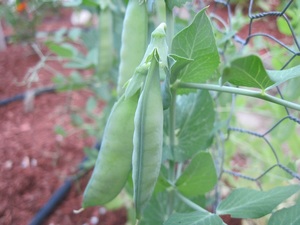
|
Pea |
3-9
Annual
Full sun
Moist
Light (sandy), Medium
2.0
Vines
Nitrogen fixer
true
Leaves, Seed, Shoots
https://en.wikipedia.org/wiki/Pea
Fabaceae or leguminosae
Erbse
https://pfaf.org/User/Plant.aspx?LatinName=Pisum sativum
Afghanistan, Albania, Algeria, Bulgaria, Corse, Cyprus, Egypt, France, Greece, Iran, Iraq, Italy, Krym, Lebanon-Syria, Libya, Morocco, North Caucasus, Palestine, Portugal, Romania, Sardegna, Sicilia, Spain, Transcaucasus, Tunisia, Turkey, Turkey-in-Europe, Turkmenistan, Ukraine, Yugoslavia
Alabama, Altay, Amur, Andaman Is., Assam, Austria, Baltic States, Bangladesh, Belarus, Belgium, Buryatiya, California, Canary Is., Cayman Is., Central European Rus, China North-Central, China South-Central, Chita, Colombia, Costa Rica, Cuba, Czechoslovakia, Dominican Republic, East Aegean Is., East European Russia, East Himalaya, Ethiopia, Fiji, Haiti, Idaho, Illinois, India, Irkutsk, Kamchatka, Kazakhstan, Kenya, Khabarovsk, Kirgizstan, Korea, Krasnoyarsk, Laos, Madeira, Magadan, Marianas, Maryland, Mexico Southwest, Mongolia, Mozambique, Myanmar, Nepal, New Guinea, New South Wales, New York, New Zealand North, New Zealand South, Nigeria, North European Russi, Northwest European R, Oregon, Pakistan, Primorye, Puerto Rico, Rwanda, Sakhalin, South Australia, South European Russi, South Georgia, Sri Lanka, Tadzhikistan, Tibet, Trinidad-Tobago, Tuva, Uganda, Uzbekistan, Vermont, Vietnam, Washington, West Himalaya, West Siberia, Yakutskiya, Yemen
Lathyrus oleraceus
https://powo.science.kew.org/taxon/urn:lsid:ipni.org:names:501912-1
3-5 years
0.3
https://powo.science.kew.org/taxon/urn:lsid:ipni.org:names:60454055-2
|
Peas are a type of legume, native to western Asia and the Near East. They are an annual plant, meaning they grow, flower, and produce seeds within a single growing season. Peas have tendrils that allow them to climb, and their leaves are typically made up of two oblong leaflets and a tendril on a single petiole. Peas produce clusters of small, fragrant flowers that can be white, pink, or purple in color. The flowers give way to pod-like fruits that contain the peas. Peas are a cool-season crop, and prefer to grow in well-drained soil that is high in organic matter. They can tolerate some shade, but will produce the best yields when grown in full sun. Peas can be differentiated from similar plants by their tendrils and the clusters of small, fragrant flowers that they produce. Peas are a relatively small plant, typically growing to a height of one to two feet. They can be grown in rows or as a companion plant, and will typically take between 60 and 90 days to reach maturity. Peas are not winter hardy, and should be planted in the spring as soon as the soil can be worked. Peas are edible, and the seeds inside the pods can be eaten fresh or dried for storage. The leaves and stems of the pea plant can also be eaten, and are a good source of vitamins and minerals. Peas can be used in a variety of dishes, and are a common ingredient in soups, stews, and casseroles. In addition to their culinary uses, peas are also valued for their ability to fix nitrogen in the soil. This makes them a valuable crop for improving soil fertility, and they are often grown as a cover crop or rotated with other crops to improve the overall health of the soil. Peas are also valued by wildlife, and their flowers and seeds are a favorite food for birds and other animals. |
Show
Edit |
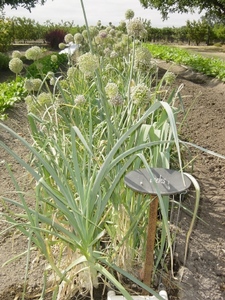
|
Allium porrum |
5-9
Full sun
Moist
Light (sandy), Medium
0.9
Herbs
Pest control, Repels carrot rust flies
Flowers, Leaves, Root
Seed - transplant
https://en.wikipedia.org/wiki/Leek
Garden leek
Alliaceae, Liliaceae
https://pfaf.org/User/Plant.aspx?LatinName=Allium porrum
sow indoors in containers from Feb., transplant early summer
15cm
Feb. - April
6.0-6.5
< 65°F
Albania, Algeria, Baleares, Bulgaria, Cyprus, East Aegean Is., Egypt, Ethiopia, France, Greece, Iran, Iraq, Italy, Kriti, Lebanon-Syria, Libya, Morocco, Palestine, Portugal, Romania, Sardegna, Sicilia, Sinai, Spain, Transcaucasus, Tunisia, Turkey, Turkey-in-Europe, Turkmenistan, Uzbekistan, Yugoslavia
Alabama, Argentina Northeast, Azores, Baltic States, Belarus, California, Canary Is., Central European Rus, Cuba, Czechoslovakia, Dominican Republic, East European Russia, Galápagos, Great Britain, Haiti, Illinois, Ireland, Kentucky, Madeira, Mexico Central, Mexico Northeast, Mexico Northwest, Mexico Southeast, Mexico Southwest, New South Wales, New York, North European Russi, Northwest European R, Pakistan, Puerto Rico, South Australia, South European Russi, Tasmania, Tennessee, Texas, Ukraine, Victoria, Western Australia
Allium ampeloprasum
https://powo.science.kew.org/taxon/urn:lsid:ipni.org:names:332079-2
May - July
0.15
https://powo.science.kew.org/taxon/urn:lsid:ipni.org:names:528646-1
true
|
The leek is a member of the onion family. It is native to the eastern Mediterranean and parts of Asia. The plant has long, flat, glossy leaves that are typically green in color. It has a white stem that widens into a bulb at the bottom. The plant has a distinctive, onion-like aroma and flavor. Leek plants grow to a height of around one to two feet and have a spread of six to eight inches. They grow relatively slowly, taking around three to four months to reach maturity. Leeks can be distinguished from other members of the onion family by their larger size and more elongated shape. Leek plants prefer moist, well-drained soil and full sun. They can be grown in a variety of soil types but prefer a slightly alkaline pH. To cultivate leeks successfully, a grower should plant them in trenches or hills and keep the soil moist throughout the growing season. Leeks are winter hardy and can be grown in most climates. Usually sown in containers or seed beds first and then moved to their final place a few months later. Leeks are edible and can be used in a variety of dishes. The edible parts of the plant are the white stem and the tender inner leaves. Leeks can be stored in the refrigerator for several weeks after harvest. In addition to their use in cooking, leeks have a number of other uses. They can be used medicinally to treat a variety of conditions, including coughs and respiratory problems. |
Show
Edit |